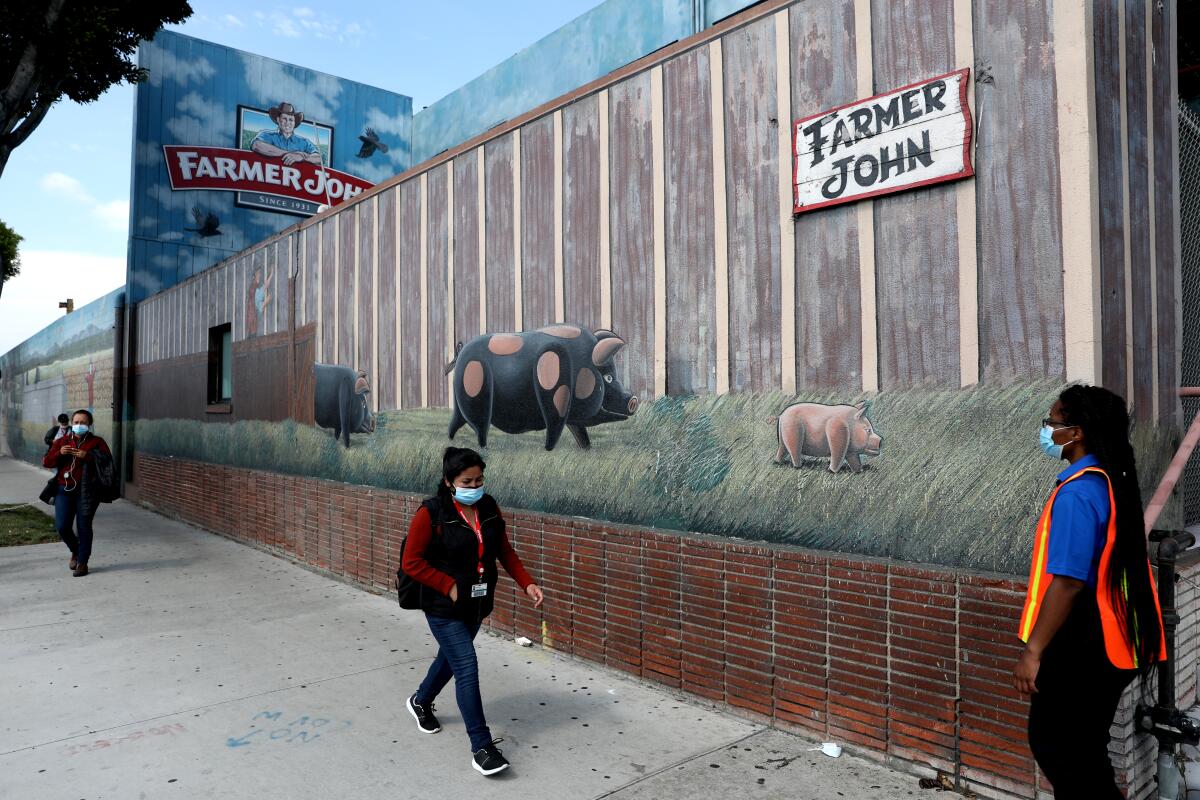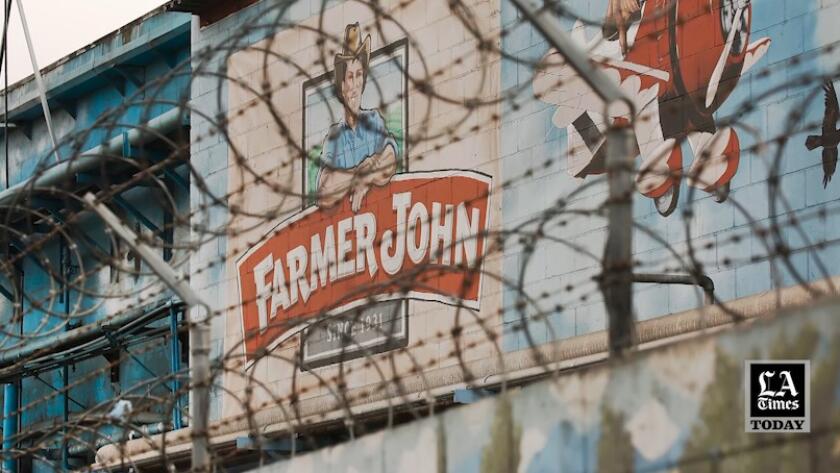End of the line for Farmer John, a smelly L.A. landmark of Dodger Dogs, tourists, protests

- Share via
Visitors to Los Angeles often put on their list of city sights the Hollywood sign, the Venice boardwalk, the Watts Towers, and for the more adventurous and olfactory-challenged, the Farmer John’s meatpacking plant in Vernon.
A favored destination for location scouts, for aficionados of camp, muralists and hot dog connoisseurs, this hidden-away abattoir was less distinguished for what took place inside its walls than for its civic packaging.
From the corners of Bandini Boulevard, Soto Street and Vernon Avenue, tourists and locals alike can take in scenes of a bucolic, agrarian past such as Los Angeles has never known. Painted pigs gambol in green fields by meandering streams under blue, cloud-studded skies happily oblivious of the fate that awaited them within.
That fate took a slightly different turn Friday when the owner of the facility, Smithfield Foods, announced the facility will close early next year. The Virginia-based company said that this step is necessary due to “the escalating cost of doing business in California.”
The fate of the building has yet to be determined. “We are exploring all our options,” said Jim Monroe, vice president of corporate affairs for Smithfield.
Yet, he added, “Farmer John is alive and well, and we will be providing the great, healthy, nutritious products that Farmer John customers have come to expect” but from another location.
The city of Vernon was less sanguine. “We are saddened,” City Manager Carlos Fandino said.
“Farmer John’s closure announcement represents another nail in California’s coffin, indicative of yet another prominent business set to leave the state,” Vernon Chamber of Commerce President Marisa Olguin said.
- Share via
Watch L.A. Times Today at 7 p.m. on Spectrum News 1 on Channel 1 or live stream on the Spectrum News App. Palos Verdes Peninsula and Orange County viewers can watch on Cox Systems on channel 99.
As a consequence of the move, workers at the plant — between 1,800 and 2,000 — are left to wonder what comes next.
Monroe said that Smithfield is providing a $7,500 bonus to employees to continue to work during the closing, and the union representing the meatpackers in Vernon issued a statement expressing hope that another operator will take over the plant and workforce.
Animal rights protesters have long made the plant a favored site for their demonstrations, accusing Smithfield of animal cruelty and worker exploitation and calling on lawmakers to ban slaughterhouses and factory farms in California. (If pigs could fly: For a time, goose liver was off the menu.)
Meanwhile, workers at the plant would not speak on record about the closing, but one employee, who gave his name only as Omar, said Smithfield Foods had described an “all hands on deck” meeting Thursday morning, and employees were instructed not to talk to the news media.
Omar said the company and the meatpacking union had struggled with negotiations. “I guess Smithfield thought it was easier to close the plant,” he said.
One worker who was hired within the last few months said that information was sparse and that “nobody really knows anything about our jobs or our future.”
“It sucks because we just want to work,” he said.
Neighbors in Vernon were more forthcoming with their opinions.
Herman Valle, who works across the street at the Green Olive Mediterranean restaurant on Soto Street, will be relieved to be done with the “terribly strong” odor he attributed to the plant.
On Monday, he said, a pair of outdoor diners were enjoying breakfast on the patio when they quickly grabbed their plates and dashed inside. It wasn’t the first time.
“It’s usually around 9 a.m. that the smell is so strong and powerful that we have to close the doors,” Valle said. “Everyone eating outside runs inside because it’s so strong.”
Agustín Álvarez, manager of the adjacent El Primo Mexican diner, was less certain the plant is responsible for the stench.
“It’s easy to point to the big factory and say the smell is coming from there,” he said. “We’re in a city of factories and plants. The smell can come from anywhere, including the river and other rendering plants.”
Álvarez, however, is less concerned about the smell than the loss of jobs.
“My heart goes out to the workers who lost their jobs,” he said. “They come in, maybe about 50 or more a day, so it’s a big loss all around.”
The plant’s New Year’s Eve order — 70 trays of rice and 70 trays of beans — was a nice holiday bonus, said Álvarez.
For many Angelenos though, the loss may be anticlimactic. Many are still reeling from the decision at the end of the 2019 Dodger season by Smithfield not to renew its contract with the team in blue.
The world-famous, footlong Farmer John Dodger Dogs were no more, and fans lost a familiar brand (Papa Cantella’s Dodger Dogs just doesn’t have the same ring to it) made even more famous by the legendary voice that hawked it.
“Easternmost in quality, westernmost in flavor,” their pitchman, Vin Scully, intoned for nearly a half-century, words that almost rivaled his famous opening line: “It’s time for Dodger baseball!”
In a city that changes so often, nostalgia is a hard notion for Angelenos to live with, but Smithfield’s decision puts into jeopardy a treasured artistic landmark.
When Leslie A. Grimes lifted his paintbrush outside the Clougherty meatpacking plant in 1957, the city was more tolerant of its less than delicate industries.
In Vernon at one time, there were more than 60 packing plants and 12 slaughterhouses.
Close by the Los Angeles River, this overlooked stretch of the city was straight out of “The Jungle,” Upton Sinclair’s muckraking look at the meatpacking industry in Chicago. But Grimes’ portrait was decidedly less scathing.
Working on a mostly cinder-block canvas covering more than 30,000 square feet, he lavished his somewhat bizarre trompe l’oeil featuring more than 200 piggies (yes, they have been counted), allowing motorists and pedestrians to indulge a Tom Sawyer/Sadie Hawkins-esque vision of pig farming where Farmer John might actually be Old MacDonald’s next-door neighbor.
For 11 years, Grimes — an Austrian immigrant and former movie-scene painter — labored over the vignettes, even once indulging a portrait of himself on 37th Street standing on a ladder painting a pig. Norman Rockwell would be proud.
But as the ancient sages once mused, ars longa, vita brevis (life is short, art is long), and in 1968, Grimes came to an unfortunate end, falling to his death from a scaffold outside the plant.
His replacement, Arno Jordan, accepted the mantle of responsibility for maintaining and upgrading the work.
When asked by The Times if he ever thought about the pig he was painting in anything other than aesthetic terms, Jordan replied, “No … I didn’t want to spoil my appetite.”
More to Read
Sign up for Essential California
The most important California stories and recommendations in your inbox every morning.
You may occasionally receive promotional content from the Los Angeles Times.













